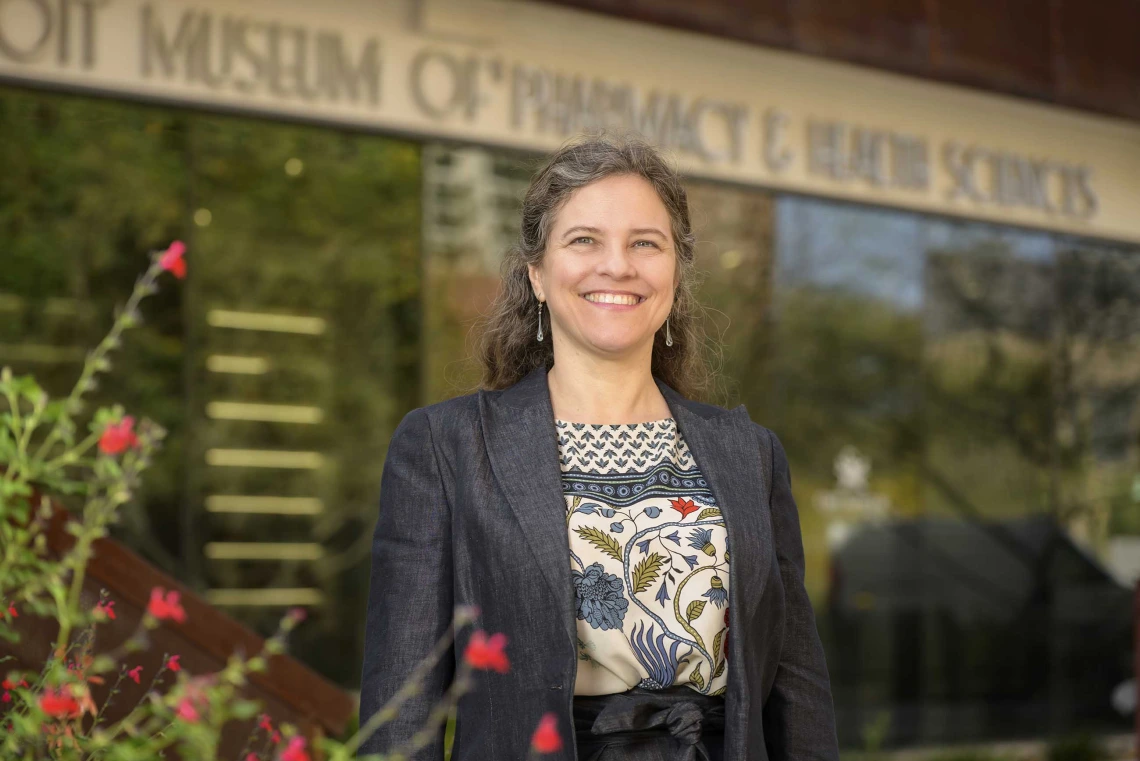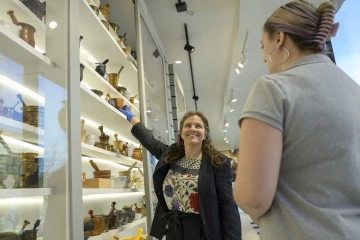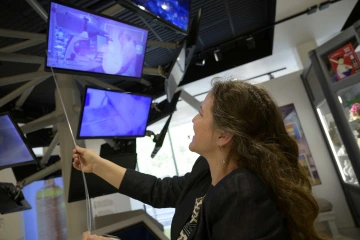Turning the historical into a modern piece of art
Coit Museum director Heather Ingram brings an art-lover’s touch to Health Sciences’ presentation of the medical past.

Heather Ingram brings her love of history, art and culture to her role as Coit Museum of Pharmacy and Health Sciences director.
Photo by Kris Hanning, U of A Health Sciences Office of Communications
Beauty is in the eye of the beholder, the old saying goes. For Heather Ingram, MA, director of the Coit Museum of Pharmacy and Health Sciences, beauty can be found in art, culture, old medicine bottles and, yes, even the chair you might be sitting on.
“I have always been fascinated with why people do the things they do,” she said. “I see objects in a museum and paintings — any type of art — as a moment in time. You learn more about what's happening in that culture and that time frame by the materials used, what’s depicted, and the level of artistry that goes into it. I've always been interested in that component, the stories that objects tell and the stories that people tell.”

Heather Ingram, left, reaches for an antique mortar and pestle in the Coit Museum while talking with student worker Milana Venegoni.
Photo by Kris Hanning, U of A Health Sciences Office of Communications
For visitors to the Coit Museum, housed in the R. Ken Coit College of Pharmacy, those objects and materials reflect the evolution of health care not only in the state of Arizona but around the world. The museum, which is open for tours by appointment only, has thousands of individual artifacts of pharmacy and medical history on display.
During a tour, visitors can experience:
- A re-creation of an old-time drugstore, with period-appropriate displays and pharmaceutical artifacts
- Pharmacy's history in the Great Moments in Pharmacy exhibit, which features 40 digitized and animated paintings
- Collections from the UpJohn Pharmacy at Disneyland 1955-1970
- A hands-on opportunity to create a “snake oil” labels for medicine bottle to take home.
The museum, originally established in 1966, features one of the largest collections of its kind in the country. It outgrew its space over the years, but thanks to a $50 million gift from R. Ken Coit in 2021 , that included $2 million for the museum, a dedicated space was created and additional exhibits were developed.
“Right now we have a lot of visitors that come in who have some sort of connection to pharmacy or the health sciences, so they're going to experience this space completely different than someone who is not very familiar with the history of either,” Ingram said. “I want it to be a space where all people can walk away feeling like they learned something. I think there are so many ways that you can make the fields of pharmacy and health science approachable to visitors. And I'm excited to find ways to explore that.”
Lifetime of merging history, art and culture
Ingram, who was the U of A BRIDGES assistant director for three years after joining as a program manager, became museum director in October 2024, has always had a love of museums. During her sophomore year at Sabino High School in Tucson, her parents wanted her to volunteer somewhere, so she called the city’s volunteer office. She was assigned to the Tucson Children’s Museum, working the front desk and giving tours. That experience led to a lifetime of loving the merger of history, art and culture found in museums.

Heather Ingram’s lifetime love of history, art and culture have an opportunity to enlighten visitors to the history of pharmacy and health sciences in Arizona and beyond.
Photo by Kris Hanning, U of A Health Sciences Office of Communications
After a few years of courses at Northern Arizona University, she transferred to the U of A and moved back to Tucson to earn her bachelor’s degree in cultural anthropology and later her master’s in art history.
“I saw art history and anthropology as a way of answering those questions about why people do the things they do for myself,” she said.
Gigs at the Arizona History Museum, the Arizona State Museum and the Center for Creative Photography were wrapped around time at the BIO5 Institute, where she was a co-director with the Keep Engaging Youth in Science, or KEYS, program.
While at BIO5, Ingram said she used to walk past the pharmacy exhibit in the third-floor lobby of the Skaggs building. Fast forward to 2022, when a redesign and relaunch of the museum gave it a dedicated space with interactive displays.
“For the people who would like to be immersed in that territorial pharmacy experience, or the old-time drugstore, that's still available. Which is lovely and an important part of the museum’s history,” she said. “But when I went to the Coit Museum, I was struck by how different it was. It's very modern and I love how the objects are celebrated, not just for their history but for their beauty.
“In a way, it's set up like an art museum. And with my background, that's a great way to celebrate seeing those connections between history and art and science. This was a visible manifestation of that.”
Getting her hands dirty
Those connections extend beyond the museum for Ingram. When she isn’t working on exhibits in the museum or planning programming, she can be found refinishing and restoring mid-century modern furniture as a hobby.
Dressers, side tables, coffee tables, dining room tables and chairs — they all get Ingram’s touch to return to their glory days of the mid-20th century.
“I have my own Instagram page with followers,” she said. “Occasionally, people even hire me to refinish their furniture.”
Ingram said the hobby started a few years ago when her son wanted to update his bedroom. She looked on Facebook Marketplace and found a mid-century modern dresser that he liked. They ended up designing his room with pieces in that style, but they often came in less-than-ideal states. And where necessity is the mother of invention, refinishing furniture through stripping, sanding and repairing gave her son’s room a complete makeover.
The hobby is more than just a way to reduce, reuse and recycle sought-after furniture.
“I took on this hobby, in part, because my position at the time wasn’t as creative as I was used to and I needed an outlet,” she said. “Now, that pressure is off (by working in the museum), but I still really enjoy doing it. It’s pretty much just a weekend thing, but you know, I get my respirator on and my gloves and my apron, and I work on furniture for a few hours at a time” she said with a chuckle.
While the museum is still open by appointment only, Ingram said she can often be found climbing around inside displays and adjusting fixtures.
“It seems every time the dean sees me, I am carrying around a tool!” she said with a laugh.
Whatever it takes to keep the creative juices flowing.

